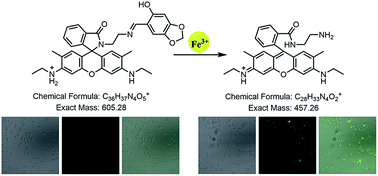A rhodamine-6G-based “turn-on” fluorescent probe for selective detection of Fe3+ in living cells†
Abstract
A new fluorescent probe R6GES based on rhodamine 6G was designed and synthesized for the detection of Fe3+. The Fe3+ irreversibly binds to the R6GES and induces the ring opening and hydrolyzing of the spirolactam in the rhodamine unit. In the case of other biologically relevant metal ions, including Al3+, Na+, K+, Li+, Ag+, Cu2+, Mg2+, Zn2+, Co2+, Fe2+, Cd2+, Ni2+, Mn2+, Ba2+, Ca2+ and Hg2+, a negligible change was observed under similar conditions. These results indicate that probe R6GES can be used for the detection of Fe3+ without interference from other competitive metal ions. The tested concentration range and the limit of detection (LOD) of the probe were 0–30.00 μmol L−1 and 0.030 μmol L−1, respectively. The present probe was applied to the determination of Fe3+ in drinking water samples. The average recoveries ranged from 102.40% to 104.55% at a spiked concentration level of 20.00 μmol L−1, and the obtained results were consistent with those obtained using atomic absorption spectrometry (AAS). Furthermore, the fluorescent probe can also be applied as a bioimaging reagent for Fe3+ detection in BEL-7402 cells.



 Please wait while we load your content...
Please wait while we load your content...